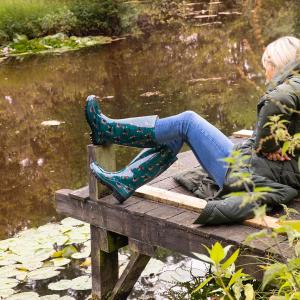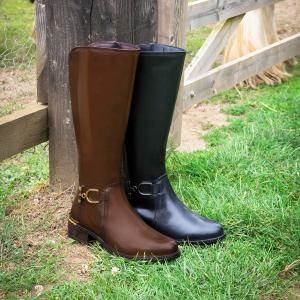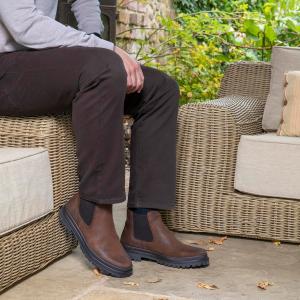One of life’s great joys is the freeing feeling of being in the great outdoors, and, with our native weather, that can often lead to wet weather and muddy conditions. Whether you are embarking on a lengthy winter walk or just pottering in the garden, there is always the chance of getting caught in a sudden downpour! Don’t let the chance of a spot of mud or rain on your favourite shoes spoil your day out, with the correct aftercare there are ways to get your boots and shoes in tip-top condition again.
Cleaning Muddy Shoes: A Comprehensive Guide
Mud-streaked shoes can be a testament to a day well-spent outdoors, but they can also be a cleaning headache. If you're puzzling over the best way to restore your footwear to its former glory, read on for a detailed, step-by-step guide.
Firstly, a proactive approach is essential. If you find yourself in a muddy situation, take a moment before heading indoors to get rid of as much mud as possible. This step not only saves your indoor flooring but also simplifies the cleaning process. If you're near natural elements like a grassy patch or a shallow stream, use these to your advantage. Gently rubbing your shoes against grass or giving them a brief rinse can dislodge wet mud, making the subsequent cleaning much more straightforward.
Now, when it comes to the cleaning, the approach slightly varies based on the shoe type. For sturdy, waterproof styles such as Wellington boots, a hose can be your best friend. Gently spray from the top to the bottom, ensuring the insides remain dry. If your shoes aren't waterproof, patience is key. Let the mud dry completely, then brush it off. Dried mud often flakes off easily, simplifying the process.
As you transition to detailed cleaning, setting up correctly can make a world of difference. Place your shoes on newspapers or an old towel to catch any drips or debris. Create a cleaning solution with warm water and a mild soap, like dishwashing liquid. Here's a tip: aim for a sudsy consistency but not overwhelmingly so. Using a soft brush, cloth, or even an old toothbrush, scrub your shoes gently in circular motions. This movement is particularly effective around intricate details and fastenings, where mud often hides.
After your shoes are clean, it's vital to let them dry naturally. Direct heat sources can warp shoes or dry out materials, especially leather. So, find a cool, well-ventilated spot and let nature do its work. And once dry, don't forget the finishing touches. Depending on the material of your shoe, applying a conditioner or protector can keep them looking and feeling their best. For example, leather shoes will thank you for a good rub with a quality leather conditioner.
In conclusion, while muddy shoes might seem like a challenge, with the right approach, they're easy to tackle. Regular care ensures that your footwear, whether standard or wide fit, stays in prime condition for years to come. So, the next time you find yourself with mud-caked shoes, remember these steps, and they'll be clean in no time!
Can You Put Muddy Shoes in the Washing Machine?
Most shoes, especially those crafted from delicate materials such as leather or suede, are best kept away from the washing machine's rigorous cycles. The combination of water, detergent, and aggressive motion can lead to warping, fading, and, in some cases, irreversible damage. Moreover, mud and debris can also clog the machine, leading to potential malfunctions.
However, there are exceptions. Certain athletic and fabric-based shoes, specifically designed for machine washing, might fare well. But before tossing them in, always shake off the excess dried mud outdoors and consult the shoe's care label. Even in these cases, using a mesh laundry bag, cold water, and a gentle cycle can offer added layers of protection.
In conclusion, while the washing machine might be tempting, for the longevity and beauty of your beloved footwear, it's often best to stick with manual cleaning methods. And remember, every step taken in caring for your shoes is a step towards ensuring they remain your trusty companions for many strolls to come.
How to Dry Wet Shoes
No matter what your shoes are made from, the best way to dry them is always in natural conditions. On a warm summer’s day, you can always try drying your shoes outside, and this will also help alleviate any odours. Although not necessarily the fastest way to dry out shoes, drying shoes naturally will ensure that materials, fastenings, and glues maintain the best condition they can.
Putting shoes or boots near a direct source of heat such as a fire or a radiator may cause a distortion in the fit and shape of the shoes, and can damage materials, such as drying out leather, which is a natural and porous material. If you have water that has soaked into the interior and lining of your shoes, adding scrunched-up tissue paper to them can help soak it up.
How to Remove Dried Mud
So, you’ve not managed to catch the mud whilst it was wet, and it has now dried onto your footwear. Don’t despair! There is a chance that a great deal of the mud will simply come off with a bang. Banging the sole against a wall or outdoor surface can often shake some of the dried mud free. For the mud that remains, try using a dry brush to brush off the lingering dirt.

How to Clean Muddy Wellies
It’s fair to say that Wellington boots are sure to get a little bit dirty in their lifetime, that’s what they are there for! So, what is the best way to clean them?
To stop bringing mud into the house, the best way to clean muddy wellies is to give them a hose down with a hose pipe outside if you have one. Gently hose the wellies using the water, being sure to pay extra attention to the soles where mud could get stuck in grooves. The best time to rinse them is straight after wearing them, when the mud is still usually wet and will come off easier. If you have been to the beach, salt and sand can help the rubber and dyes deteriorate, so it is best to wash them as soon as you can after wearing them. If you don’t have a hose pipe, a bucket of water with a few drops of washing-up liquid and a sponge or cloth will also work just as well. Don’t forget to check the zips and buckles for hidden mud!
What Should I Have in my Care Kit?
Creating a shoe care kit is a great way to know that you have everything you need to look after your footwear. Our cleaning kit essentials are shoe cream, horse hair brushes, wax polish, lint-free cloths, and a welt brush. Keeping some newspaper handy is also always useful to protect your floors. This set of maintenance essentials will allow you to look after the care of your Pavers shoes and boots with ease.
What is the difference between waterproof and water resistant?
Waterproof and water-resistant have two slightly different meanings which describe the level of protection against water that the shoe will give you. Water resistance has the ability to resist water, but only to a certain point, whereas waterproof technically means that it is impermeable to water, thus offering a stronger level of protection.
Can You Waterproof Shoes?
If you have a pair of shoes or boots at home that you think you might like to wear in potentially wet weather, you can enhance their water resistance with a few handy shoe care products. Waterproofing sprays are a simple way to waterproof your shoes quickly. Remove any laces or additional detachable details from the shoes and apply the product per packaging instructions. You can also try waterproofing waxes and creams for your footwear, simply use like you would a leather conditioner to a water resistant coating to your shoes.


